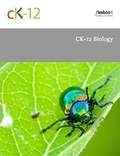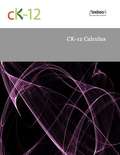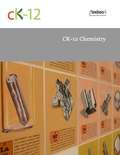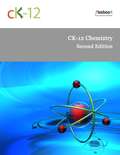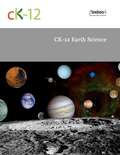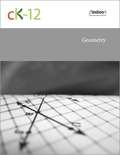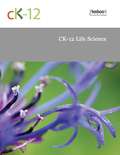- Table View
- List View
CK-12 Biology I (with image descriptions)
by Ck-12 FoundationOpen source biology textbook from CK-12.
CK-12 Biology I - Honors
by Ck-12 FoundationCK-12 Foundation's Biology 1- Honors FlexBook Covers the following chapters:<P><P> Foundations of Life Science- scientific investigations, methods, observations, & communication.<P> Chemical Basis of Life- matter, the significance of carbon, lipids, proteins.<P> Cell Structure and Function- prokaryotic, eukaryotic, plant, & animal cell features; structures / functions of DNA, RNA, protein, cell transport, homeostasis.<P> Photosynthesis- water, carbon, and nitrogen cycle between abiotic and biotic resources.<P> Cellular Respiration- relation to glycolysis, Krebs Cycle, electron transport chain.<P> Cell Division and Reproduction- cell division, reproduction.<P> Mendelian Genetics- inheritance, sex-linked traits.<P> Molecular Genetics- DNA, RNA, protein synthesis, mutation, regulating gene expression.<P> Human Genetics- human genome, diseases, Biotechnology- DNA technology, gene cloning.<P> History of Life- evolution, macroevolution, extinctions, episodic speciation, response to change.<P> Evolutionary Theory- Darwin's Theory of Evolution, common ancestry and natural selection.<P> Evolution in Populations- genetics of populations, genetic diseases, natural selection.<P> Classification- Taxonomy, scientific classification of organisms.<P> Principles of Ecology- Ecology's relation with energy; ecosystems, the water, carbon, and nitrogen cycles.<P> Biomes, Ecosystems and Communities- terrestrial/ aquatic biomes, community interactions.<P> Populations- Analysis of populations and dynamics.<P> Ecology and Human Actions- Balance between humans and the earth addressing natural resources, ecosystems, & biodiversity.<P> The Human Body- systems.<P> Nervous and Endocrine Systems- structures & functions, homeostasis.<P> Skeletal, Muscular, and Integumentary Systems- structures, functions, & homeostasis.<P> Circulatory and Respiratory Systems- structures and functions.<P> Digestive and Excretory Systems- structures/ functions, food pyramid.<P> Immune System and Disease- Body defenses against pathogens.<P> Reproductive System and Human Development- human reproductive systems, reproductive lifecycle, STDs.
CK-12 Calculus
by Ck-12 FoundationCK-12 Foundation's Single Variable Calculus FlexBook covers the following chapters: Functions, Limits, and Continuity - A review of the basics of functions is given. Students use linear approximations to study the limit process, before a more formal treatment of limits is given. Differentiation - Students explore instantaneous rate of change, and the relationship between continuity and differentiability. The Chain Rule and implicit differentiation are reviewed. Applications of Derivatives - Students gain practice with using the derivatives in related rates problems. Additional topics include The First Derivative Test, The Second Derivative Test, limits at infinity, optimization, and approximation errors. Integration - This chapter includes indefinite integrals calculus, initial value problems, definite integrals, the Fundamental Theorem of Calculus, integration by substitution, and numerical integration. Applications of Integration - This chapter includes applications of the definite integral, such as calculating areas between two curves, volumes, length of curves, and other real-world applications in physics and statistics. Transcendental Functions - This chapter includes differentiation and integration of logarithmic and exponential functions, exponential growth and decay, derivatives and integrals involving inverse trigonometric functions, and L'Hospital's Rule. Integration Techniques - Students explore integration by substitution, integration by parts, integration by partial fractions, trigonometric integrals, trigonometric substitutions, and improper integrals. Infinite Series - This chapter introduces the study of sequences and infinite series. The properties presented describe the behavior of a sequence or series, including whether a sequence approaches a number or an infinite series adds to a number.
CK-12 Chemistry
by Ck-12 FoundationCK-12 Foundation's Chemistry FlexBook Covers the following chapters: The Science of Chemistry- scientific method, history, matter, energy. Chemistry: A Physical Science- measurement, formulas. Chemistry in the Laboratory- qualitative vs. quantitative observation. The Atomic Theory- atomic model from Dalton to Rutherford. The Bohr Model of the Atom- electromagnetic radiation, atomic spectra & Bohr model. Quantum Mechanics Model of the Atom- energy and standing waves, Heisenberg's uncertainty principle, Schrödinger's equation. Electron Configurations for Atoms- electron spin, Aufbau principle. Electron Configurations and the Periodic Table- relation of electron configuration to position on the periodic table. Relationships Between the Elements- chemical families from electron configuration; valence electrons, Lewis dot formulas. Trends on the Periodic Table- periodic trends: atomic size. Ions and the Compounds They Form- ionization, ionic bonding. Writing and Naming Ionic Formulas- predicting charge. Covalent Bonding- nature and naming of covalent bonds. Molecular Architecture- polar molecule, electronic/ molecular models of covalent molecules. Chemical Reactions- mass & mole calculations, reaction types. Mathematics and Chemical Equations- stoichiometry, heat of reaction. The Kinetic Molecular Theory- gas properties, combined and universal gas laws. The Liquid State- phase change. The Solid State- intermolecular forces. Solution Process- solvation, concentration, solubility, colligative properties. Ions in Solution- dissociation, electrolytes, non-electrolytes, ionic/ net-ionic equations. Chemical Kinetics- reaction rate. Chemical Equilibrium- reaction rates, equilibrium constant, Le Chatelier's principle, solubility product constant. Acids and Bases- strength of acids & bases, hydrolysis, pH. Water, pH, and Titration- dissociation of water, acid-base indicators, buffers. Thermodynamics- bond breaking and formation, heat of reaction and formation, Hess' law, entropy, Gibb's free energy. Electrochemistry- oxidation-reduction, electrochemical cells. Nuclear Chemistry- radioactivity, nuclear equations/ energy. Organic Chemistry- hydrocarbons, functional groups.
CK-12 Chemistry - Second Edition
by Ck-12 FoundationCK-12 Foundation's Chemistry - Second Edition FlexBook covers the following chapters:Introduction to Chemistry - scientific method, history. Measurement in Chemistry - measurements, formulas. Matter and Energy - matter, energy. The Atomic Theory - atom models, atomic structure, sub-atomic particles. The Bohr Model of the Atom – electromagnetic radiation, atomic spectra. The Quantum Mechanical Model of the Atom – energy/standing waves, Heisenberg, Schrödinger. The Electron Configuration of Atoms – Aufbau principle, electron configurations. Electron Configuration and the Periodic Table- electron configuration, position on periodic table. Chemical Periodicity – atomic size, ionization energy, electron affinity. Ionic Bonds and Formulas – ionization, ionic bonding, ionic compounds. Covalent Bonds and Formulas – nomenclature, electronic/molecular geometries, octet rule, polar molecules. The Mole Concept – formula stoichiometry. Chemical Reactions – balancing equations, reaction types. Stoichiometry – limiting reactant equations, yields, heat of reaction. The Behavior of Gases – molecular structure/properties, combined gas law/universal gas law. Condensed Phases: Solids and Liquids – intermolecular forces of attraction, phase change, phase diagrams. Solutions and Their Behavior – concentration, solubility, colligate properties, dissociation, ions in solution. Chemical Kinetics – reaction rates, factors that affect rates. Chemical Equilibrium – forward/reverse reaction rates, equilibrium constant, Le Chatelier's principle, solubility product constant. Acids-Bases – strong/weak acids and bases, hydrolysis of salts, pHNeutralization – dissociation of water, acid-base indicators, acid-base titration, buffers. Thermochemistry – bond breaking/formation, heat of reaction/formation, Hess' law, entropy, Gibb's free energy. Electrochemistry – oxidation-reduction, electrochemical cells. Nuclear Chemistry – radioactivity, nuclear equations, nuclear energy. Organic Chemistry – straight chain/aromatic hydrocarbons, functional groups. Chemistry Glossary
CK-12 Earth Science
by Ck-12 FoundationCK-12 Foundation's Earth Science FlexBook Covers the following chapters: What is Earth Science- scientific method and branches of earth science. Studying Earth's Surface- landforms, map projections and computers/satellites. Earth's Minerals- types, formation, identification , properties and uses. Rocks- rock cycle and types of rocks. Earth's Energy- renewable and nonrenewable resources. Plate Tectonics- Earth's interior, continental drift, seafloor spreading, tectonic movement, plate boundaries, and landforms. Earthquakes- causes, prediction, safety, seismic waves/tsunamis, and rock/mountain building. Volcanoes- formation, landforms and types of magma and eruptions. Weathering and Formation of Soil- mechanical/chemical weathering and soil formation, horizions & climates. Erosion and Deposition- actions of water, wind and gravity. Evidence about the Earth's Past- fossilization and relative/absolute dating. Earth's History- geological time, early history and evolution. Earth's Freshwater- water cycle and lakes, rivers, streams & groundwater. Earth's Oceans- formation, composition, waves/tides, seafloor and ocean life. Earth's Atmosphere- properties, significance, layers, transfer of energy and movement of air. Weather- cloud types, air movement, storms, and forecasting. Climate- factors that affect climate, different climates, and global climate change. Ecosystems and Human Population- role, flow of matter/energy, carbon cycle and effect of human population growth. Human Actions and the Land- erosion and pollution. Human Actions and the Earth's Resources- renewable vs. nonrenewable and conservation & availability. Human Actions and the Earth's Water- usage, distribution, sources, pollution, and protection. Human Action and the Atmosphere- types, causes, effects and reductionObserving and Exploring Space- electromagnetic radiation, telescopes, and current discoveriesEarth, Moon and Sun- properties, motion, tides/eclipses, sun layers and solar activityThe Solar System- motion, formation, inner vs. outer planets, dwarf planets, meteors, asteroids, and comets. Stars, Galaxies and the Universe- constellations, light/energy of stars, classification, evolution, galaxies, dark matter, dark energy, and the Big Bang Theory.
CK-12 Geometry
by Ck-12 FoundationCK-12 Foundation's Geometry FlexBook covers the following chapters: Basics of Geometry - undefined terms, defined terms, basic postulates of points, lines and planes; distances on a coordinate grid; complementary and supplementary angles; vertical angles; linear pairs and classification of polygons. Reasoning and Proof - inductive reasoning, deductive reasoning, conditional statements, properties of equality and two-column proofs. Parallel and Perpendicular Lines - the parallel line postulate, the perpendicular line postulate, and angles formed by two parallel lines and a non-perpendicular transversal. Congruent Triangles - the Triangle Sum theorem, triangle congruence, the SSS and ASA postulates, the AAS congruence theorem, two-column and flow proofs, the HL congruence theorem, AAA and SSA relationships, isosceles and equilateral triangles. Relationships Within Triangles - the midsegment theorem, the perpendicular bisector theorem, the angle bisector theorem, the concurrency of medians theorem, Napoleon's theorem, and the triangle inequality theorems. Quadrilaterals - interior angles of convex quadrilaterals, classifying quadrilaterals, properties of parallelograms, properties of rhombi, rectangles and squares, and properties of trapezoids. Similarity - ratio and proportion, properties of similar polygons, AAA and AA rules for similar triangles, using SSS and SAS to solve problems about similar triangles, identifying proportional segments in triangles and similarity transformations. Right Triangle Trigonometry - using the Pythagorean theorem when working with right triangles, classification of triangles, the converse of the Pythagorean theorem, using the geometric mean, properties of special right triangles, and trigonometric ratios. Circles - relationships between congruent and similar circles, the equation of a circle, tangent lines, arc measures, chords, inscribed angles, and angles formed by chords, secants and tangents. Perimeter and Area - finding the area of polygons, using scale drawings or models, finding the circumference of a circle, areas of circles and sectors, calculating the areas and perimeters of regular polygons and geometric probability. Transformations - transformations of figures in two-dimensional space including translations, reflections, rotations and dilations.
CK-12 Life Science
by Ck-12 FoundationCK-12 Foundation's Life Science FlexBook Covers the following chapters:Studying Life- Nature of science: scientific method. tools used in science and safety in research. Introduction to Living Organisms- what they are, what they are made of, and classification. Introduces carbs, lipids, proteins, and nucleic acids. Cells and Their Structures- what they are, what they are made of, organelles and eukaryotic vs. prokaryotic. Cell Functions- ctive transport, passive transport, photosynthesis, and cellular respirationCell Division, Reproduction, and DNA- mitosis, meiosis, DNA, RNA, and protein synthesisGenetics- Mendel's peas to gene therapy. Evolution- Darwin's natural selection, history of life and evidence of evolution. Prokaryotes- properties and characteristicsProtists and Fungi- properties, characteristics, reproduction and metabolismPlants- nonvascular & vascular, gymnosperms & amniosperms and hormones/tropismsIntroduction to Invertebrates- sponges, cnidarians, and wormsOther Invertebrates- mollusks, echinoderms, arthropods, and insectsFishes, Amphibians, and Reptiles- fishes, amphibians, and reptilesBirds and Mammals- characteristics, properties, diversity and significanceBehavior of Animals- communication, cooperation, mating and cyclesSkin, Bones, and Muscles- skeletal, muscular and integumentary systemsFood and the Digestive System- nutrition and digestionCardiovascular System- heart, blood, vessels and cardiovascular healthRespiratory and Excratory Systems- breathing and elimination of wasteControlling the Body- Nervous SystemDiseases and the Body's Defenses- Diseases and the immune responseReproductive System and Life Stages- Reproduction, fertilization, development and healthFrom Populations to the Biosphere- Ecology: Communities, ecosystems, biotic vs. abiotic factors, and biomesEcosystem Dynamics- Flow of energy, recyclig of matter, and ecosystem changeEnvironmental Problems- Pollution, renewable vs nonrenewable resources, habitat destruction & extinction, and biodiversity
CK-12 Probability and Statistics (Basic)
by Ck-12 FoundationAn open source textbook on probability and statistics.
CK-12 Probability and Statistics - Basic (A Full Course)
by Ck-12 FoundationAn open source textbook.
CK-12 Single Variable Calculus
by Ck-12 FoundationIn this lesson we will review what you have learned in previous classes about mathematical equations of relationships and corresponding graphical representations and how these enable us to address a range of mathematical applications. We will review key properties of mathematical relationships that will allow us to solve a variety of problems. We will examine examples of how equations and graphs can be used to model real-life situations.
